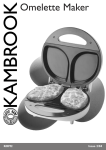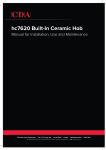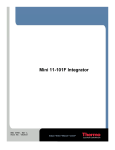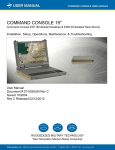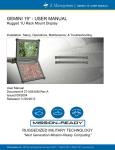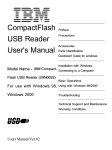Download Z Microsystems 21 User's Manual
Transcript
FIELD-READY Glider 21 User Manual Z Microsystems FCC INFORMATION 1. Use the power and video cables supplied with the Glider to help prevent interference with radio and television reception. The use of cables and adapters may cause interference with electronic equipment in the vicinity of this unit. protection against harmful interference in when equipment is operated in commercial environments. This equipment generates, uses and can radiate radio frequency energy, and, if not installed and used in accordance with the instruction manual, may cause harmful interference to radio communications. 2. This equipment has been tested and found to comply with the limits for Class “A” digital devices, pursuant to certain limits imposed by Part 15 of the FCC rules. These limits are designed to provide reasonable G L I D E R 3. Operation of this equipment in a residential area is likely to cause interference in which case the user will be required to correct the interference at his own expense. Changes or modifications not expressly approved by Z Microsystems could void user’s authority to operate the equipment. 21 2 Doc# 27-0017UM Issued 08/03 Rev 1.0 TABLE OF CONTENTS STARTING POINT Shipment Contents About User Manual System Requirements Features Product Description Tools Required for Installation Precautions 4 4 4 4 4 5 6 6 INSTALLATION 7 Slide Removal 7 Install The Slides In Cabinet Frame 8 Installation Test 10 Final Adjustments 10 Install Cables 11 SETUP Setting Up Glider 12 12 PROTECTOR REMOVAL 14 OPERATIONS Cable Connections Turn On Power Display Panel Controls Menus 15 15 15 16 18 3 Doc# 27-0017UM Issued 08/03 Rev 1.0 DISPLAY HEAD REMOVAL 21 MAINTENANCE 22 DISPLAY STOWAGE Close Glider 23 23 TROUBLESHOOTING No Image on Main Display 25 25 SPECIFICATIONS 26 APPENDIX Support Replacing Parts Providing Feedback Mechanical Outline Drawings 27 27 28 28 29 STARTING POINT Congratulations on selecting a rugged field-ready Glider, the most advanced flat panel display available. SHIPMENT CONTENTS ABOUT USER MANUAL The Glider shipping box contains the following: The User Manual comes in two formats: printed hardcopy or CDROM. This Manual is also available on the Z Microsystems website (www.zmicro.com). • The Glider Unit • Host Serial Cable • AC Power Cable We recommend you read this manual as follows: • User Manual • Protective Outer Shield (Optional) Carefully follow the instructions in the Installation chapter for hookup and initial control settings. Refer to the Operation chapter for a complete description of all the user controls, and the Maintenance chapter for care and correcting any unforeseen problems with the system. The Appendix is provided for quickly finding technical information about the Glider. • Mounting Hardware Remember to save your original shipping container and packing material to transport or ship the Glider. SYSTEM REQUIREMENTS FEATURES The Glider works with any computer system that provides industry standard screen formats from 640 x 480 to 1600 x 1200, with up to 75 Hz vertical sync. • Large Display Area • Wide Viewing Angle • Small Package Outline • Full Color • High Contrast Ratio 4 Doc# 27-0017UM Issued 08/03 Rev 1.0 STARTING POINT PRODUCT DESCRIPTION The Glider is an advanced spacesaving drawer mount high-end rugged liquid crystal display. The Glider can be oriented for a portrait format. The LCD display can quickly swing up into a reading position. The unique Glider design allows flat panels up to 21.3” to fold into a 2U (3.5”) drawer space in standard 19” racks and transit cases. Specially designed quickrelease locks hold the compact folded Glider securely in place during storage. The lightweight and durable aluminum construction provides exceptional strength in field applications. display works effectively with any workstation. An electrostatically-applied and bakedon finish is used for extreme durability for shipboard, airborne, field deployments, and industrial or lab applications where weight and size are critical. The high quality LCD screen provides full color and features up to 1600 x 1200 pixel resolution. The side-viewing angle is up to 160 degrees. The monitor can be adjusted to multi-viewing positions, and oriented either vertically or horizontally. The 5 Doc# 27-0017UM Issued 08/03 Rev 1.0 The Glider can also be easily positioned for a landscape format. STARTING POINT TOOLS REQUIRED FOR INSTALLATION Required Tools and Equipment: • Flathead screwdriver with about 10" shaft. • Phillips screwdriver with about 10" shaft. WARNING: To avoid shock hazard: • Adjustable wrench or box wrenches. • Do not remove the covers around the Glider. • Do not connect or disconnect the Glider during an electrical storm. • The power cord plug must be connected to a properly wired and grounded power outlet. • Any equipment to which the Glider will be attached must also be connected to properly wired and grounded power outlets. • The socket outlet shall be installed near the equipment and shall be easily accessible. PRECAUTIONS In preparation to install the Glider, take the following precautionary steps: NOTE: For the fastest and easiest installation of the Glider, follow these steps in the sequence they are presented. • Turn off the electrical power to your computer. • Verify the Glider power switch is off. If the Glider is off, the Power light on the display front will not be illuminated and the power switch will be down toward the circle. 6 Doc# 27-0017UM Issued 08/03 Rev 1.0 INSTALLATION SLIDE REMOVAL With the Glider laid on a workbench, press down to release the Z-Locks on each side of the front of the Glider to slide the side rails back. The slide rails will reach a stop about half way back. This is a safety stop to prevent the Glider from sliding out too far while mounted in the rack. Simultaneously press in the safety catches on each slide rail and slide the side rails all the way off the back of the Glider. 7 Doc# 27-0017UM Issued 08/03 Rev 1.0 The slides should now be separated from the Glider. INSTALLATION INSTALL THE SLIDES IN CABINET FRAME Each slide unit includes the slide rail, the front ZLock mount and the rear mount. The top notch of the ZLock must align with the slide rail top ridge. As seen from this reverse view, align the slider into the Z-Lock bracket grooves so all three screw holes show. On the front of the cabinet frame, use three Phillips screws and washers per side to secure the right and left Z-Lock mounts holding the sliders. DO NOT tighten these screws to allow for adjustment of the Glider within the cabinet frame. On the rear of the cabinet frame, use three Phillips screws to loosely secure the right and left rear slide mounts to the cabinet frame. DO NOT tighten these screws fully. On each slide rail, use a Phillips screwdriver to loosen the two adjustment screws toward the back of the slide rail. An adjustable wrench or box wrench may be used to hold the nut on the other side of the slide rail. 8 Doc# 27-0017UM Issued 08/03 Rev 1.0 At the back of the cabinest frame, tighten the slide mounts to the cabinet frame. Make sure to hold the slide mounts hard against the rack rail. INSTALLATION INSTALL THE GLIDER IN CABINET FRAME The Glider slides should move in and out easily. If not, check alignment of the slider and Z-Lock mount. Pull the two Glider slides out until they lock. Hold the Glider on each side over the back set of rollers, with the front into your stomach. The Glider MUST be level. This step may best be done with two people, one on each side of the slide rails. If the Glider binds during insertion, the Glider rollers are not properly aligned into the slider recepticle. Simultaneously press in the catches on each slider and move the Glider all the way into the cabinet frame. Feed the cables from the Glider back through the cabinet frame. Guide the Glider into the slides and slide the Glider in until it stops. 9 Doc# 27-0017UM Issued 08/03 Rev 1.0 If aligned properly, the rollers on the Glider slide smoothly into and out of the slider rails. INSTALLATION INSTALLATION TEST The Glider should easily close completely. Slide the Glider in and out several times. The Glider should slide in and out easily. Because of variances in cabinet frames, there may need to be some adjustments of the Glider slide system for best fit and movement of the Glider in and out. If the Glider binds when rolling in and out, perform the following procedures. FINAL ADJUSTMENTS Slide the Glider partially out. Use a flathead screwdriver to slightly move the Z-Locks in toward or out from the Glider, depnding on the need for best fit. While holding the Z-Locks at the proper setting, tighten the screws on the ZLock mounts. The Glider should slide in and out easily. If not, adjust the position of the two Z-Locks again. The Glider should now slide in and out smoothly. If not, repeat these steps. 10 Doc# 27-0017UM Issued 08/03 Rev 1.0 Go to the rear of the cabinet to tighten the slider extender rail scews. If there is not enough room to work at the back of the cabinet, the Glider may need to be removed to tighten the rail screws. INSTALLATION INSTALL CABLES NOTE: Be sure the AC supply is properly grounded. WARNING: Be sure all electrical power to the cabinet is off before connecting any of the cables. WARNING: There is a key guide for alignment on the cables. Be sure the cable plug and receptacles are aligned properly using the key guide. Misalignment can cause short circuiting. The power supply is mounted on the back of the Glider tray. Be sure the power plug going in to the power supply is screwed all the way in. The power supply cable should be connected to a suitable grounded AC power. The power cable comes out at the back of the power supply on the rear of the Glider tray. Be sure the plug is screwed in tightly. Ensure the equipment is installed near the power source (socket outlet) and that the outlet is easily accessible. 11 Doc# 27-0017UM Issued 08/03 Rev 1.0 SETUP SETTING UP GLIDER The outer Z-lock bracket fits snuggly against the female Z-lock bracket attached to the cabinet frame. With both hands, press both the Z-Locks down. Slide the Glider all the way out to the safety stop. If your unit is equipped with lock down features, lift and slide the two display lock knobs at the back of the display to the open or inward positions. This allows the display top to be lifted from its storage position. Push down on the latch at the base of the display. Then lift the raised latch from its receptical to the unlatched position. Rotate the latch counterclockwise to unlock the latch. Holding the base with one hand, lift the back of the pivioted display up to the vertical position. VERY IMPORTANT Once the display is locked in position, lower the latch back into the base recepticle. Hold the top of the display in the vertical position while rotating the latch clockwise to the locked position. 12 Doc# 27-0017UM Issued 08/03 Rev 1.0 SETUP SETTING UP GLIDER The display can be left in the vertical position or tilted back. The display can be rotated clockwise to angled positions. The Glider can be slid back until the back of the display almost touches the cabinet. 13 Doc# 27-0017UM Issued 08/03 Rev 1.0 The display can also be moved into the horizontal position. The control knobs will be on the bottom. PROTECTOR REMOVAL The Protective Outer Shield (optional equipment) is intended to protect the surface of the screen from damage while in transit or while stowed. The display protector is not intended to be used while the display is in operation. To remove the display protector, do the following: Rotate the display to the horizontal position, with the controls on the bottom. Move the display protector release button (located above the display) up. While holding up the display protector button, slide the protector to the right. 14 Doc# 27-0017UM Issued 08/03 Rev 1.0 Slide the protector off the edge of the display. To reinstall the display protector during long storage or shipping, just reverse this process. OPERATIONS CABLE CONNECTIONS NOTE: Connecting to nonstandard systems will require an adapter. To obtain a video adapter, contact Customer Services at Z Microsystem, Inc. NOTE: Make sure the DC connector is plugged in seated properly on the back side of the display head. TURN ON POWER Turn on the power switch on the back of the display. The unit is on when the straight line side is depressed. The unit is off when the circle side is down. The Glider has a fan that may be audible when the machine is turned on. The fan is controlled by a temperature sensor and may not turn on until the unit warms up. 15 Doc# 27-0017UM Issued 08/03 Rev 1.0 NOTE: Incorrect cable connections may result in irregular operation. Incorrect cable connections may also damage the display quality or components of the LCD module, and may shorten the life of the unit. Always consult the computer system manual. Verify the system’s compatibility to ensure proper operation. OPERATIONS DISPLAY PANEL CONTROLS The controller features push-button controls on the lower front of the display screen to adjust the brightness of the display, to change the image positioning on the screen, and to refine the screen image. To complete the setup of the display, use the following controls to fine tune the image on the screen: Z : The Z button is used to switch between available channels. NOTE: Current configuration holds only one channel. Therefore, this button can not be used to switch channel settings. If the Z button is pressed, press once more to enable the active channel (Channel A). UP: Move up through menu functions; can also be used to adjust the main screen lighting. DOWN: Move down through menu functions; can also be used to adjust the main screen lighting. LEFT: Move left to adjust value for functions. RIGHT: Move right to adjust value for functions. MENU: Activate On-Screen Menu. Also, use this button to activate the highlighted function. EXIT: On-Screen Menu. from main menu or return from sub-menus to main menu. STANDBY: Place the display in Standby or Active mode; turns the backlight on and off. 16 Doc# 27-0017UM Issued 08/03 Rev 1.0 OPERATIONS The three LED lights on the right of the control panel are labeled A, B and C. Their lighted functions are: A — VIDEO A green — VIDEO A is selected B — VIDEO B (green) green — VIDEO B is selected If A & B are both green, it indicates the Channel Auto Switching function is selected. C — Computer Graphics (green/orange) green — power and signal orange — power and no signal off — Standby mode This section explains how to use the control buttons to adjust the clarity of the display and image position on the screen. In particular it discusses: • The function of each of the push-button controls • How to reset previously saved settings or return to factory settings • Tips and techniques The control buttons allow the user to control image position, clarity and backlight operations; to store settings, and to revert to previously operations factory-saved settings. 17 Doc# 27-0017UM Issued 08/03 Rev 1.0 OPERATIONS MENUS To access the onscreen display main menu, press the menu button on the front of the panel. All Glider functions are controlled using the Main Menu’s subtopics. These submenus can be accesssed using the Up and Down buttons on the display panel. See sections below for specifics regarding the submenus. Main Screen Picture Adjust Use the Up and Down buttons to highlight the “Picture Adjust” option. Press the “Menu” button to access the submenu. Use the Left and Right buttons to increase and decrease the Brightness and Contrast characteristics of the screen. Press “Exit” to return to the Main Menu. The new adjustments will be applied automatically. NOTE: Brightness of the main screen can also be adjusted without entering the Main Menu using the up and down display buttons. 18 Doc# 27-0017UM Issued 08/03 Rev 1.0 OPERATIONS Main Screen Graphics Mode Use the Up and Down buttons to highlight the “Graphics Mode” option. Press the “Menu” button to access the “Graphics Mode” submenu. This submenu is used to adjust the positioning of the image pixels within the screen. Use the Left and Right buttons to adjust the following modes: Horz Coarse, Horz Fine, H Pos, and V Pos. Press “Exit” to return to the Main Menu. The new adjustments will be applied automatically. Main Screen Color Balance Use the Up and Down buttons to highlight the “Color Balance” option. Press the “Menu” button to access the “Color Balance” submenu. 50 50 Use the Left and Right buttons to adjust the colors of the screen image. 50 Press “Exit” to return to the Main Menu. The new adjustments will be applied automatically. 19 Doc# 27-0017UM Issued 08/03 Rev 1.0 OPERATIONS Main Screen Information Use the Up and Down buttons to highlight the “Information” option. Press the “Menu” button to access the “Information” submenu. Within this submenu, video mode resolution, the refresh rate, the sync mode, and the firmware version installed on the unit are displayed. Main Screen Configuration Use the Up and Down buttons to highlight the “Configuration” option. Press the “Menu” button to access the “Configuration” submenu. Within this submenu, the following items can be accessed: Menu Timeout: The amount of time the menu will appear while not in use before it times out. When the menu times out, it disappears from the main screen. Reset Default Settings: Resets all Main Menu settings to the factory default settings. Auto Position: This feature will center the image on the screen. In order for this feature to function properly, ensure the image does not have a black border and that the image is the proper size to fill the screen. Channel Select: If more than one channel is not purchased, this option will be invalid. To ensure the available channel is active, set the default to Channel A. 20 Doc# 27-0017UM Issued 08/03 Rev 1.0 DISPLAY HEAD REMOVAL WARNING: Be sure all electrical power is turned off to the Glider before proceeding. To remove the Glider display head, follow these steps: Rotate the display to the horizontal position. On the back of the display, disconnect the power cable. Disconnect the host serial cable. Disconnect the video cable. On the back of the display, press the mounting arm button to release the display head locking bar. Swing the display locking bar out. Use two hands to lift the display up out of the rack mount. Be careful that the power and video cables do not catch on anything. The display is now removed from the head mount. 21 Doc# 27-0017UM Issued 08/03 Rev 1.0 MAINTENANCE CLEAN MONITOR WARNING: Be sure to turn off the power before performing any maintenance on the monitor. WARNING: To avoid risk of electric shock, DO NOT dissemble the monitor cabinet. User maintenance is restricted to cleaning as explained here. • Gently wipe the covers and the screen with a soft cloth. • Remove finger marks and grease with a damp cloth and mild detergent or alcohol. DO NOT use solvents or abrasives. • Never use flammable cleaning material to clean the monitor or other ectrical apparatus. 22 Doc# 27-0017UM Issued 08/03 Rev 1.0 DISPLAY STOWAGE CLOSE GLIDER The following describes closing and stowage of the Glider in the cabinet. Pull the Glider all the way out. Tilt the display head back. From the landscape position, rotate the display to the vertical position. Make sure there is enough room to lower the top of the display head without hitting the cabinet. VER Y IMPORT ANT VERY IMPORTANT Rotate the display locking latch counterclockwise to release the side lock linkage. Tilt the display head back towards the rear of the rack all the way to the horizontal position in order to... ...lower the display into the Glider frame tray. Hold the top of the display while rotating the locking latch. 23 Doc# 27-0017UM Issued 08/03 Rev 1.0 Rotate the locking latch clockwise to engage the side lock linkage. DISPLAY STOWAGE CLOSE GLIDER The display latch has now locked the side linkage. Lower the pivot latch into its recepticle. Slide the Glider into the frame until the Z Locks snap into the closed, secure position. 24 Doc# 27-0017UM Issued 08/03 Rev 1.0 Slide the two display locking bolts at the back of the display to the closed position to secure the display. TROUBLESHOOTING NO IMAGE ON MAIN DISPLAY If there is no image on the main screen, a signal will appear on the screen that states, “No Input, Check Cable”. If the cable from the computer to the display is secure, determine the color of the standby LED and follow the appropriate procedure below. BLACK Cause: If the standby LED is black, there is no power to the unit. Recovery: • Ensure the power cable is plugged into the source. • Connect the power cable to the AC outlet. Ensure the AC outlet is active. • Wake up the display by pressing the standby button. ORANGE Cause: If the standby LED is orange, there is no video signal. Recovery: • Ensure there is a video signal coming from the computer. • If no image appears, press the Z button on the control panel. • If this fails to activate the image, use the on-screen menu. Within the Configuration menu is the “Channel Select” option. Switch between A and B to activate the proper channel. GREEN Cause: When the standby LED is green, there is both power and a video signal. If there is no image on the main display, there is a possible hardware failure. Recovery: • Ensure the video signal coming from the computer is not a black screen. • Contact Z Microsystems’ Customer Support Department. 25 Doc# 27-0017UM Issued 08/03 Rev 1.0 SPECIFICATIONS SPECIFICATIONS Display size 21.3 Inch (432.0 mm x 324.0 mm) Pixels 1600 x 1200 Colors 16.7 Million Contrast Ratio 400:1 Luminescence 250 cd/m2 (max) Interface 2 Ch. LVDS Response Time Rising 20 msec, Falling 15 msec Backlight 6 CCFL Viewing Angle 80/80 Control Control Panel or SoftMenu Power Power Consumption 80 W Power Supply 85-264 VAC @ 47-63 Hz, 400 Hz, 1A Cabling Display Cable 6’ cable, optional Power Cable 6’ cable, IEC Total Packaging Size 3.5”H x 27”D x 19”W Weight 41 lbs Operating Temp 0 to +40C Extended Operating Temp* -20 to +50C Non-Op Temp -40 to +70C Operating Humidity 5%-95% Non-Condensing Non-Op Humidity 5%-95% Non-Condensing Operating Altitude 1,300 to 15, 000 ft. Non-Op Altitude 1,300 to 40,000 ft. Vibration MIL-STD-167 Shock MIL-STD 810E, 20 g’s, MIL-STD-901D (in isolated rack) Sand and Dust 5.5 MPH for 25 min (display head only) Drip Proof MIL-STD-810E (display head only) Fungus Non-Nutrients/Contaminants Reliability MTBF 20,000 hrs w/ backlight change at 10,000 hrs. Ground fixed environmental IAW MILHDBK-217F calculation technique Maintainability <30 minutes Safety UL 1950 EMI FCC Class A Quality/Workmanship IPC/ISO 9002 and applicable section of MILHDBK-454 * Unit will power up and is legible at -20°C; backlight life is reduced 26 Doc# 27-0017UM Issued 08/03 Rev 1.0 APPENDIX SUPPORT If you are unable to correct any problem yourself, contact Z Microsystems at: (858) 657-1000 Fax: (858) 657-1001 Website: www.zmicro.com Before calling, please have available as much of the following information as possible: 1. Model and serial number from the label on the monitor 2. Purchase Order number 3. Description of problem 4. Computer type and model 5. System configuration (hardware fitted, etc.) NOTE: If possible, stay by the computer. The Z Microsystems Technical Support Representative may wish to go through the problem over the telephone. 6. System BIOS version number 7. Operating System and version number 8. Display driver version number 9. Video Adapter type NOTE: More help, latebreaking news and details of the latest accessories for these products may be found on the worldwide web at: http://www.zmicro.com 27 Doc# 27-0017UM Issued 08/03 Rev 1.0 APPENDIX REPLACING PARTS If the Z Microsystems Technical Support Engineer determines that the product needs to be replaced, a Customer Service Representative will issue a Return Material Authorization (RMA) number and return address. A RMA number is required to return a product to Z Microsystems, regardless of the reason for the return. The following information is required when returning Z Microsystems products: 1. Model number 2. Serial number 3. Date of purchase 4. Proof of purchase (use the invoice or packing slip) 5. Customer ship-to address and any special shipping requirements 6. Specific and detailed description of the problem PROVIDING FEEDBACK We value your feedback on our products and their performance, and always welcome constructive suggestions. Please send such productive information in writing to: Customer Service Z Microsystems 5945 Pacific Center Blvd., Suite 505 San Diego, CA 92121 or www.zmicro.com 28 Doc# 27-0017UM Issued 08/03 Rev 1.0 APPENDIX MECHANICAL OUTLINE DRAWINGS 29 Doc# 27-0017UM Issued 08/03 Rev 1.0 APPENDIX 30 Doc# 27-0017UM Issued 08/03 Rev 1.0 APPENDIX 31 Doc# 27-0017UM Issued 08/03 Rev 1.0 APPENDIX 32 Doc# 27-0017UM Issued 08/03 Rev 1.0 APPENDIX 33 Doc# 27-0017UM Issued 08/03 Rev 1.0 Z Microsystems, Inc. 5945 Pacific Center Blvd., Suite 505 San Diego, CA 92121 Phone: (858) 657-1000 Fax; (858) 657-1001 Website: www.zmicro.com Copyright 1999 Z Microsystems, Inc. All Rights Reserved




































